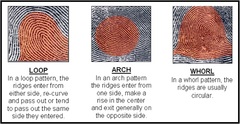Calling all investigators! The Kids Ahead team from SMU needs your help with a fingerprint lab at the 2012 USA Science and Engineering Festival April 27-29, 2012. Join us at the Kids Ahead booth (booth #3323) to participate in this activity.
Background
Fingerprints are the oldest biometric and one of the most useful for forensics. In the 1800s people began to classify and compare fingerprints. In 1880, Police started taking fingerprints of criminals in Paris and by 1924, the FBI had a fingerprint collection with hundreds of inked cards. By the 1960s, the Royal Canadian Police had over a million fingerprints and began to store them on video tape. In the mid-1970s video tape storage was replaced by the first computer automated fingerprint identification system (AFIS). Today, the FBI's computer database contains over 200 million fingerprints.
What makes fingerprints so useful for crime scene investigation? Even though we can't always see them, fingerprints are left behind whenever we touch something. Our hands have oils and sweat and when the water evaporates, the oil leaves a fingerprint behind. Police can dust objects with dark powder which sticks to the oil, then special tape is placed over it to peel off the fingerprint patterns. Fingerprints are frequently found on weapons during crime scene investigations.
 Think of all of the detail in fingerprints. Did you know that even identical twins do not have the same fingerprints? In order to compare against a large number of fingerprints, it is easier if we classify and break them into smaller groups. Scotland Yard developed a system in the late 1800s to label fingerprint patterns as an arch, loop, or whorl.
Think of all of the detail in fingerprints. Did you know that even identical twins do not have the same fingerprints? In order to compare against a large number of fingerprints, it is easier if we classify and break them into smaller groups. Scotland Yard developed a system in the late 1800s to label fingerprint patterns as an arch, loop, or whorl.
In addition to general classification, there are small details called minutiae that are used to compare fingerprints. We can note where ridges cross over or end. When a ridge splits it is called a bifurcation. The valleys between the ridges can also be compared; a delta is a 3-way valley and the small dots are sweat pores.
When we compare fingerprints, we won't always get an exact match. Often we touch things with the tips or sides of our fingers, so we may need to rotate the prints in order to compare them.
Technology has enhanced the fingerprint recognition process. A computer can quickly search and compare millions of fingerprints to find the closest matches. Computers use complex algorithms, or math equations, to identify fingerprints by measuring the distance between different minutiae. This allows the comparison and identification of fingerprints to occur much more quickly and accurately than it does when we try to do it manually.
Objective:
Gain experience with collecting fingerprints and learn the basics of fingerprint recognition
Equipment:
Balloon (obtained from the Kids Ahead booth)
Ink Pad (if doing the activity from home)

Activity:
1. You will be given an uninflated balloon at the Kids Ahead booth. After gathering ink on your finger, place your fingerprint on the balloon. Once you return home, blow up your balloon in order to see your fingerprint in epic proportions!
2. Identify and label your fingerprint using the pattern classifications. Is your fingerprint a loop, arch or whorl? (See pictures above for details)
3. Find and identify the different minutiae in your fingerprint by circling them on your balloon. Look carefully, you probably have more than one!
4. Count how many of each minutiae you were able to find and write it on a piece of paper.



















What other people thought